The Gas Insulated Transmission Lines Market is estimated to be valued at USD 558.9 million in 2025 and is projected to reach USD 876.3 million by 2035, registering a compound annual growth rate (CAGR) of 4.6% over the forecast period. Analyzing the data reveals gradual increments in value, with no sudden surges or sharp declines. From 2025 to 2027, the market grows moderately from USD 558.9 million to USD 611.5 million, reflecting a steady foundational phase.
The period between 2028 and 2030 shows continued consistent growth, with values rising from USD 639.6 million to USD 699.8 million. These increments indicate stable demand and gradual technology adoption. Between 2031 and 2035, the market advances from USD 732.0 million to USD 876.3 million, representing the highest absolute growth phase within the forecast. This phase signifies increasing market maturity, improved infrastructure projects, and steady investments.
The absence of abrupt fluctuations in values implies a low-risk growth trajectory. The incremental gains at each breakpoint highlight that the market is developing in a predictable manner, offering a reliable opportunity for long-term stakeholders. The CAGR of 4.6% is modest but reflects the market’s resilience and ongoing demand in power transmission sectors. The breakpoint analysis indicates steady, incremental expansion over the forecast horizon.
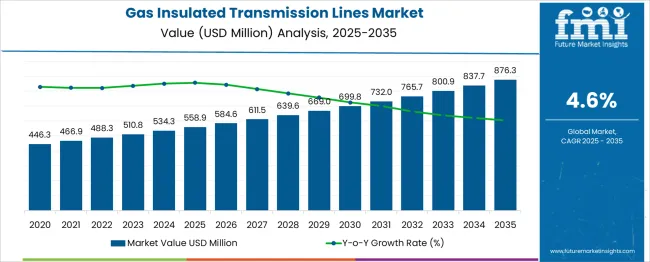
| Metric | Value |
|---|---|
| Gas Insulated Transmission Lines Market Estimated Value in (2025 E) | USD 558.9 million |
| Gas Insulated Transmission Lines Market Forecast Value in (2035 F) | USD 876.3 million |
| Forecast CAGR (2025 to 2035) | 4.6% |
As conventional overhead transmission becomes challenging in congested corridors and difficult terrains, gas insulated alternatives are being favored for their compact footprint and reliability. Enhanced dielectric strength, lower electromagnetic interference, and reduced maintenance requirements are reinforcing the adoption of gas insulated systems in both new installations and retrofitting projects. Governments and transmission operators are also endorsing such solutions to meet energy transition goals, ensuring grid resilience and sustainability.
The demand for higher-rated voltage lines and tunnel installations is growing in response to increasing urban energy demand, cross-border interconnections, and integration of renewables. The combination of operational longevity, minimal land use, and compatibility with underground construction techniques positions gas insulated transmission lines as a future-ready solution for global transmission challenges.
The gas insulated transmission lines market is segmented by rated voltage, installation method, application end user, and geographic regions. The gas-insulated transmission lines market is divided into 230 to 500 kV Gas Insulated Transmission Lines, 115 to 220 kV Gas Insulated Transmission Lines, and 550 to 1200 kV Gas Insulated Transmission Lines. In terms of installation method, the gas-insulated transmission lines market is classified into Tunnel Installation of gas-insulated transmission Lines, Aboveground Installation of gas-insulated transmission Lines, Vertical Installation of gas-insulated transmission Lines, and Direct Burial of gas-insulated transmission Lines.
The gas insulated transmission lines market is segmented into AC Current Gas Insulated Transmission Lines and DC Current Gas Insulated Transmission Lines. The end users of the gas-insulated transmission lines market are segmented into Power Transmission & Distribution, Power Generation Plants, Oil & Gas Industry, Chemical Industry, Cement Industry, Mining Industry, Marine Industry, IT & Telecommunication, Railways, and Others. Regionally, the gas insulated transmission lines industry is classified into North America, Latin America, Western Europe, Eastern Europe, Balkan & Baltic Countries, Russia & Belarus, Central Asia, East Asia, South Asia & Pacific, and the Middle East & Africa.
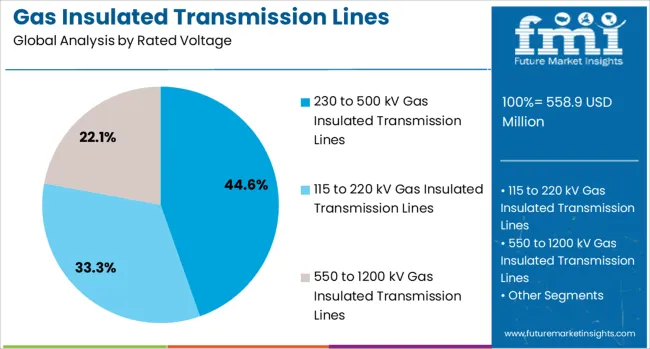
The 230 to 500 kV subsegment is anticipated to hold 44.6% of the total revenue share in the rated voltage segment of the gas insulated transmission lines market in 2025. The rising demand for high-capacity drives this dominance, long-distance transmission infrastructure that ensures minimal power loss.
These voltage levels have been increasingly favored due to their ability to support efficient bulk power transfer across urban and inter-regional grids. The growing integration of renewable energy into national grids has required robust transmission solutions capable of managing intermittent loads and distant power sources, which this voltage range effectively supports.
The segment's leadership is also supported by its adaptability to various grid conditions and its compatibility with tunnel and underground installations. Advancements in insulation technologies and SF6 gas alternatives have further enabled the safe and stable operation of transmission systems within this voltage class, reinforcing its continued preference in modern infrastructure development.

Tunnel installation is expected to represent 48.3% of the total revenue share in the installation method segment of the gas insulated transmission lines market in 2025. This leading position is attributed to the growing emphasis on underground power transmission in high-density urban areas where surface space is limited.
Tunnel-based deployment has become increasingly viable due to its capacity to house high-voltage lines with minimal environmental impact and enhanced protection against external hazards. Utility companies and project developers are selecting tunnel installations to address regulatory concerns, aesthetic demands, and safety standards, particularly in metropolitan and industrial zones.
The segment’s strength is further bolstered by its alignment with smart city planning and long-term grid modernization initiatives. Innovations in tunnel boring technologies and fire-resistant design materials have also improved the economic feasibility and operational safety of such installations, making them an integral component of advanced transmission infrastructure planning.
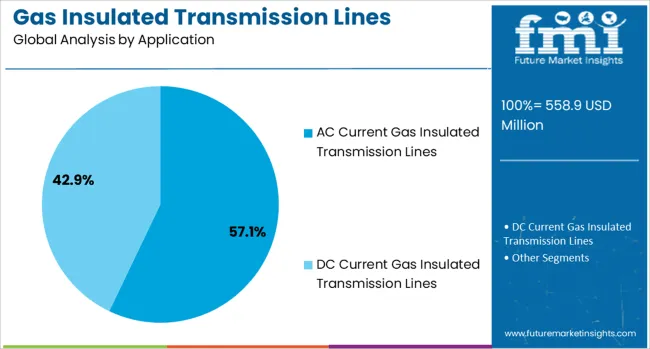
The AC current subsegment is projected to account for 57.1% of the total revenue share in the application segment of the gas insulated transmission lines market in 2025. This segment’s dominance is being reinforced by the widespread presence and compatibility of alternating current transmission in national and regional grids.
AC gas insulated lines are being increasingly deployed in retrofit and extension projects due to their seamless integration with existing substations and transmission networks. Their operational efficiency in handling varying load profiles and their suitability for short-to-medium distance transmission have made them the preferred solution in many power distribution projects.
The segment’s growth is also being supported by regulatory preferences for mature and tested transmission frameworks, as well as lower upfront costs compared to HVDC alternatives. The ability of AC gas insulated lines to provide consistent performance with reduced right-of-way requirements and superior fault containment is contributing to their continued adoption across both public and private grid infrastructure developments.
Gas insulated transmission lines utilize sulfur hexafluoride (SF6) gas to insulate conductors, enabling high voltage transmission within a smaller footprint compared to conventional overhead lines. This technology has been extensively adopted in urban and industrial environments where space constraints and safety considerations limit overhead infrastructure deployment. The market expansion has been supported by growing investments in smart grid and renewable energy projects, requiring reliable and low-loss transmission systems.
Urban expansion and industrial development have necessitated compact and reliable transmission infrastructure, resulting in increased adoption of gas insulated transmission lines. In congested metropolitan areas, underground and enclosed transmission lines are preferred to avoid right-of-way issues, reduce electromagnetic interference, and enhance public safety. These lines have been widely installed in substations, tunnels, and industrial plants to support power distribution and minimize outage risks. Infrastructure modernization programs in developed and emerging economies have integrated gas insulated transmission technology to replace aging overhead lines and enhance system reliability. The ability to transmit high-voltage power over long distances with reduced footprint has made these lines suitable for integration with renewable energy sources and smart grid applications. Consequently, urbanization and grid upgrading efforts remain key drivers of market growth.
Significant advancements in gas insulated transmission line technology have improved insulation materials, joint design, and monitoring capabilities. Development of advanced composite materials and corrosion-resistant coatings has extended the lifespan and reliability of these lines in harsh environments. Innovations in sealing and gas management systems have minimized SF6 leakage, addressing environmental concerns associated with this greenhouse gas. Online partial discharge monitoring and diagnostic tools have been integrated to enable predictive maintenance and reduce unexpected failures. Modular and prefabricated gas insulated line segments have facilitated faster installation and reduced downtime. The research into alternative insulating gases with lower global warming potential is underway to improve environmental compliance. These technological enhancements have made gas insulated transmission lines more efficient, safer, and environmentally sustainable.
The increasing adoption of renewable energy sources such as wind and solar has been positively influencing the gas insulated transmission lines market. These lines offer efficient and reliable solutions for transmitting power from remote renewable generation sites to urban centers. Their compact design and high reliability are well-suited for integration with offshore wind farms, solar parks, and distributed energy systems. Gas insulated transmission lines support grid stability by minimizing transmission losses and improving fault tolerance. The growth of smart grids incorporating renewable energy assets has further driven demand for these advanced transmission solutions. Investments in large-scale renewable infrastructure projects and government incentives aimed at clean energy transition have accelerated market adoption globally, positioning gas insulated transmission lines as critical components of modern energy networks.
Regulatory focus on reducing greenhouse gas emissions and environmental impact has influenced the gas insulated transmission lines market significantly. SF6, the primary insulating gas used, is a potent greenhouse gas with a high global warming potential, prompting regulations to limit its release and encourage alternative solutions. Manufacturers have been investing in gas handling, recycling technologies, and leakage prevention systems to comply with stringent environmental standards. Emerging regulations on electrical grid safety and performance have also driven the adoption of gas insulated transmission technologies with advanced monitoring features. Opportunities have arisen in developing eco-friendly insulating gases and hybrid systems combining gas insulation with solid dielectric materials. Market growth will be shaped by the ability to balance performance, safety, and environmental compliance while meeting increasing electricity transmission demands.
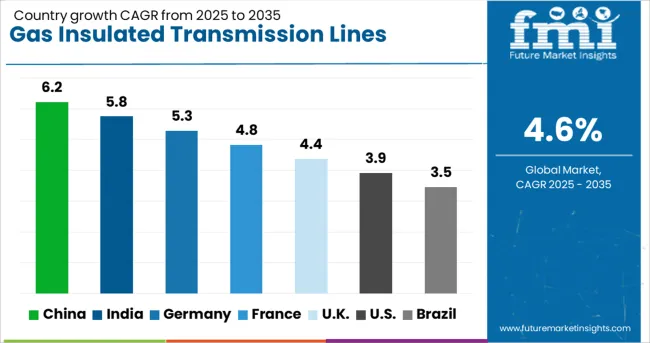
| Country | CAGR |
|---|---|
| China | 6.2% |
| India | 5.8% |
| Germany | 5.3% |
| France | 4.8% |
| UK | 4.4% |
| USA | 3.9% |
| Brazil | 3.5% |
The market is forecasted to grow at a CAGR of 4.6% between 2025 and 2035, driven by the need for reliable and compact power transmission solutions amid rising energy demand. China leads with a 6.2% CAGR, supported by large-scale grid modernization projects and urban power infrastructure expansion. India follows at 5.8%, fueled by increasing electrification and transmission network upgrades. Germany, at 5.3%, benefits from investments in smart grid technologies and enhanced energy efficiency. The UK, growing at 4.4%, focuses on integrating compact transmission systems within urban centers. The USA, with a 3.9% CAGR, experiences steady growth driven by grid resilience and sustainability initiatives. This report includes insights on 40+ countries; the top markets are shown here for reference.
China’s demand for gas insulated transmission lines is forecasted to expand at a CAGR of 6.2% from 2025 to 2035, driven by the need to enhance power grid reliability and accommodate increased electricity loads. Major players such as State Grid Corporation of China and China XD Group are investing in advanced GIS technology to improve transmission efficiency and reduce maintenance costs. The integration of renewable energy sources into the national grid requires robust and compact transmission solutions. Government policies promoting smart grid modernization accelerate market growth, focusing on urban and industrial power distribution networks.
India is expected to grow at a CAGR of 5.8% through 2035, supported by ongoing efforts to upgrade aging power infrastructure. Companies such as Larsen & Toubro and BHEL are expanding GIS installations to reduce transmission losses and improve grid stability. The growing industrial sector and rising power demand encourage adoption of compact, high-voltage transmission solutions. Government initiatives aimed at expanding rural electrification and smart grids further stimulate market expansion. Collaborative projects with international technology providers contribute to innovation and deployment.
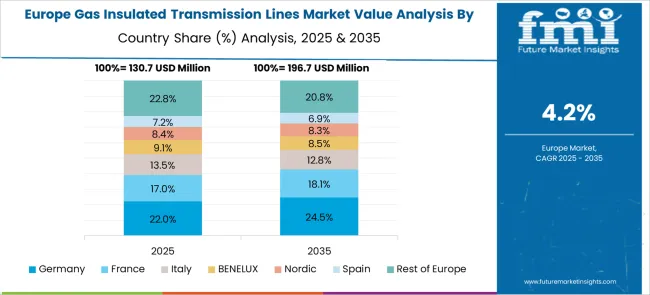
Germany’s market for gas insulated transmission lines is projected to grow at a CAGR of 5.3% between 2025 and 2035, driven by the transition towards decentralized power generation and renewable integration. Key companies including Siemens and ABB are focusing on developing compact GIS solutions suitable for urban substations and offshore wind farms. The emphasis on energy efficiency and grid resilience supports the expansion of gas insulated technologies. Federal incentives for grid modernization projects further boost demand in industrial and utility sectors.
The United Kingdom’s demand for gas insulated transmission lines is expected to expand at a CAGR of 4.4% through 2035, fueled by power grid modernization and efforts to support renewable energy transmission. Industry leaders such as National Grid and Schneider Electric are implementing GIS technology to optimize space usage and improve reliability in congested urban areas. The shift towards offshore wind and decentralized generation requires robust transmission infrastructure. Government-backed smart grid initiatives encourage the adoption of advanced GIS components across power networks.
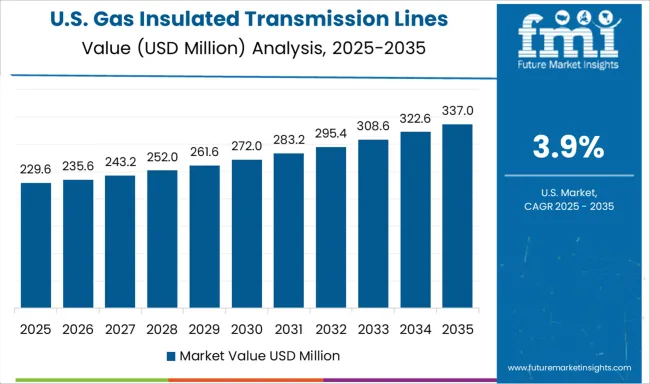
The United States market for gas insulated transmission lines is forecasted to grow at a CAGR of 3.9% from 2025 to 2035, supported by modernization of aging transmission networks and increasing integration of renewables. Leading companies such as General Electric and Prysmian Group focus on developing high-voltage GIS solutions to enhance grid efficiency and reduce environmental footprint. Federal infrastructure programs encourage upgrading transmission corridors in urban and industrial zones. Research on advanced insulating gases and eco-friendly technologies is gaining momentum to meet regulatory standards.
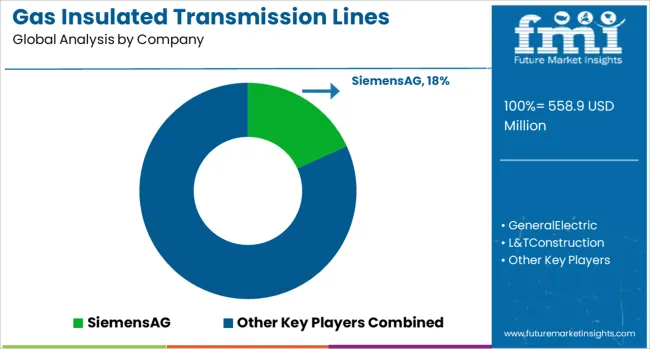
The GIL market is dominated by Siemens Energy, ABB, Hitachi Energy, Toshiba, and CG Power Systems, which collectively control most large-scale, high-voltage deployments globally. Siemens Energy differentiates through ultra-high-voltage GIL systems with modular designs, enabling rapid installation in constrained urban and industrial sites, and leverages predictive diagnostics and digital monitoring for reduced maintenance cycles. ABB focuses on hybrid GIL designs combining minimal SF₆ usage and high-pressure insulation for megawatt-scale grid interconnections, emphasizing retrofits and cross-border transmission projects. Hitachi Energy targets reliability-critical applications such as LNG terminals and offshore substations, offering corrosion-resistant designs and advanced jointing technologies. Toshiba and CG Power Systems concentrate on regional large-capacity projects in Asia-Pacific and the Middle East, using cost-optimized, pre-fabricated GIL units with shorter lead times.
Competition is primarily dictated by voltage class capability, modularity, insulation medium optimization, service network, and project execution speed, rather than price. Market share is skewed toward OEMs capable of delivering turnkey solutions for ultra-high-voltage applications and fast-track urban deployments. Regional players compete in medium-voltage retrofits and localized industrial corridors but lack scale for cross-border megaprojects. Strategic differentiation increasingly hinges on hybrid insulation designs, lifecycle service contracts, and digital monitoring integration for operational continuity.
| Item | Value |
|---|---|
| Quantitative Units | USD 558.9 Million |
| Rated Voltage | 230 to 500 kV Gas Insulated Transmission Lines, 115 to 220 kV Gas Insulated Transmission Lines, and 550 to 1200 kV Gas Insulated Transmission Lines |
| Installation Method | Tunnel Installation of Gas Insulated Transmission Lines, Aboveground Installation of Gas Insulated Transmission Lines, Vertical Installation of Gas Insulated Transmission Lines, and Direct Burial of Gas Insulated Transmission Lines |
| Application | AC Current Gas Insulated Transmission Lines and DC Current Gas Insulated Transmission Lines |
| End User | Power Transmission & Distribution, Power Generation Plants, Oil & Gas Industry, Chemical Industry, Cement Industry, Mining Industry, Marine Industry, IT & Telecommunication, Railways, and Others |
| Regions Covered | North America, Europe, Asia-Pacific, Latin America, Middle East & Africa |
| Country Covered | United States, Canada, Germany, France, United Kingdom, China, Japan, India, Brazil, South Africa |
| Key Companies Profiled | SiemensAG, GeneralElectric, L&TConstruction, BetaEngineering, GrupoCOBRA(ACSGroup), TBEAEnergy, AZZInc., and JiangnanGroupLimited |
| Additional Attributes | Dollar sales by transmission capacity and application type, demand dynamics across urban infrastructure, industrial complexes, and renewable energy integration, regional trends in deployment across Asia-Pacific, Europe, and North America, innovation in compact designs, advanced gas mixtures, and enhanced insulation materials, environmental impact of sulfur hexafluoride (SF6) leakage, energy efficiency, and recycling of components, and emerging use cases in smart grid modernization, underground urban networks, and offshore wind farm connections. |
The global gas insulated transmission lines market is estimated to be valued at USD 558.9 million in 2025.
The market size for the gas insulated transmission lines market is projected to reach USD 876.3 million by 2035.
The gas insulated transmission lines market is expected to grow at a 4.6% CAGR between 2025 and 2035.
The key product types in gas insulated transmission lines market are 230 to 500 kv gas insulated transmission lines, 115 to 220 kv gas insulated transmission lines and 550 to 1200 kv gas insulated transmission lines.
In terms of installation method, tunnel installation of gas insulated transmission lines segment to command 48.3% share in the gas insulated transmission lines market in 2025.
Explore Similar Insights

Thank you!
You will receive an email from our Business Development Manager. Please be sure to check your SPAM/JUNK folder too.
Chat With
MaRIA